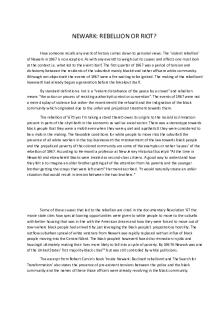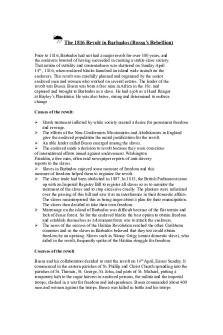Summary-Cry of Rebellion PDF

| Title | Summary-Cry of Rebellion |
|---|---|
| Author | ELAIKA MALTU |
| Course | MST |
| Institution | Saint Paul University Philippines |
| Pages | 3 |
| File Size | 69.5 KB |
| File Type | |
| Total Downloads | 424 |
| Total Views | 571 |
Summary
CRY OF REBELLIONI. PRIMARY SOURCESGuillermo MasangkaySource: Guillermo Masangkay, “Cry of Balintawak” in Gregorio Zaide and Sonia Zaide, Documentary Sources of Philippine History, Volume 8 (Manila: National Book Store, 1990), 307-309.On 26 August 1896, after the Katipunan was discovered, Masangkay j...
Description
CRY OF REBELLION I. PRIMARY SOURCES Guillermo Masangkay Source: Guillermo Masangkay, “Cry of Balintawak” in Gregorio Zaide and Sonia Zaide, Documentary Sources of Philippine History, Volume 8 (Manila: National Book Store, 1990), 307-309.
On 26 August 1896, after the Katipunan was discovered, Masangkay joined Bonifacio, Emilio Jacinto and others in a big meeting held at Apolinario Samson’s house in Caloocan. The purpose was to discuss when the uprising was to take place. Those who have attended the meeting was Bonifacio, Emilio Jacinto, Aguedo del Rosario, Tomas Remigio, Enrique Pacheco, Francisco Carreon, Briccio Pantas, Teodoro Plata, and Pio Valenzuela. They were all leaders of the Katipunan and composed the board of directors of the organization. Pantas, Plata, and Valenzuela were all opposed to starting the revolution too early. The leaders questioned the wisdom of an open rebellion due to the lack of arms and logical support. However, after Bonifacio’s intense and convincing speech, everyone destroyed their cedulas to symbolize their defiance of Mother Spain and together, raised the cry of “revolt”.
Pio Valenzuela Source: Pio Valenzuela, “Cry of Pugad Lawin” in Gregorio Zaide and Sonia Zaide,Documentary Sources of Philippine History, Volume 8 (Manila:National Book Store, 1990),301-302. Andres Bonifacio, Emilio Jacinto, Procopio Bonifacio, Teodoro Plata, & Agueda del Rosario arrived first in their place of refuge, Balintawak on August 19, 1896. Dr. Pio Valenzuela arrived in place the next day. On August 22, 500 KKK members gathered in the house of Apolonio Samson. Here, views are only exchanged, and no resolution was debated or adopted. It was at Pugad Lawin, the house, store-house, and yard of Juan Ramos, son of Melchora Aquino, where over 1,000 members of the Katipunan met and carried out considerable debate and discussion on August 23. The discussion was whether or not start the revolution against the Spanish government should be started on August 29. After the tumultuous meeting, many of those present tore their cedula and shouted “Long live Philippines! Long live Philippines!”
II. CONTROVERIES AND DISAGREEMENTS Nineteenth-century journalists used the phrase “El Grito de Rebelion” or “Cry of Rebellion” to mark the start of revolutionary events which happened in August 1896, northeast of Manila, where they declared rebellion against the Spanish colonial government.
Controversies arise as to when and where this event happened. Various accounts of the Cry give different dates and places. A guardia civil, Lt. Olegario Diaz, identify the Cry to have happened in Balintawak on August 25. Teodoro Kalaw, Filipino historian, marks the place to be in Kangkong, Balintawak on the last week of August. Santiago Alvarez, a Katipunero and son of Mariano Alvarez, puts the cry in Bahay Toro in Quezon City on24 August. Pio Valenzuela, known Katipunero, stated that the Cry happened in Pugad Lawin on August 23. Historian Gregorio Zaide identified it to happen in Balintawak on August 26.According to the statements of Pio Valenzuela, Teodoro Agoncillo puts the Cry at Pugad Lawinon 23 August. Research by historians Milagros Guerrero, Emmanuel Encarnacion, and Ramon Villegas claimed that the event took place in Tandang Sora’s barn in Gulod, Barangay Banlat, Quezon City on August 24. All these dates are of the same year, 1896. The historian Teodoro Agoncillo chose to emphasize Bonifacio’s tearing of the cedula (tax receipt) before a crowd of Katipuneros who then did the same. However, Guardia Civil Manuel Sityar never mentioned in his memoirs the tearing or inspection of the cedula, but did note the pacto de sangre (blood pact) mark on every single Filipino he met in August 1896. On the other hand, some writers consider the first military engagement with the enemy as the defining moment of the Cry, for which, Emilio Aguinaldo commissioned a “Himno deBalintawak” to herald renewed fighting after the failed peace of the pact of Biyak na Bato. On 3 September 1911, a monument to the Heroes of 1896 was erected in what is now the intersection of Epifanio de los Santos Avenue and Andres Bonifacio Drive – North Diversion Road. From that time on until 1962, the Cry of Balintawak was officially celebrated every 26August. The site of the monument was chosen for an unknown reason.
But the issue did not rest there. In 1970, the historian Pedro A. Gagelonia pointed out: The controversy among historians continues to the present day. The “Cry of Pugad Lawin” on August 23, 1896 cannot be accepted as historically accurate. It lacks positive documentation and supporting evidence from the witness. The testimony of only one eyewitness - Dr. Pio Valenzuela, is not enough to authenticate and verify a controversial issue in history. Historians and their living participants, not politicians and their sycophants, should settle this controversy.
III. RESOLUTION OF THE ISSUE Teodoro Agoncillo used his considerable influence and campaigned for a change in the recognized site to Pugad Lawin and the date 23 August 1896. In 1963, the National Heroes Commission (a forerunner of the NHI), without formal consultations or recommendations to President Macapagal. Consequently, Macapagal ordered that the Cry of Balintawak be called the “Cry of Pugad Lawin,” and that it be celebrated on 23 August instead of 26 August. The 1911 monument in Balintawak was later removed to a highway. In 1962, Agoncillo, together with the UP-Student Council, placed a marker at the Pugad Lawin site. According to Agoncillo, the house of Juan Ramos stood there in 1896, while the house of Tandang Sora was located at Pasong Tamo. In spite of the absence of any clear evidence, the NHI disregarded its own 1964 report that the Philippine Historical Committee had determined in 1940 that the Pugad Lawin residence was Tandang Sora’s and not Juan Ramos’s and that the specific site of Pugad Lawin was Gulod in Banlat. On the basis of the 1983 committee’s findings, the NHI placed a marker on 23 August 1984 on Seminary Road in barangay Bahay Toro behind Toro Hills High School, the Quezon City General Hospital and the San Jose Seminary.
IV. CONCLUSION AND RECOMMENDATION The Cry of the Rebellion marked the start of the Philippine Revolution in 1896 which eventually led to Independence of the country in 1898. This event showed not just bravery and courage of the Filipino people; this also utilized the unity of the Filipinos which is rooted to their “thirst” for independence. It was a cry for freedom as they had finally realized their need to fight in order to prove themselves and be called truly free men. With the existence of the Cry, we actually got the independence that our heroes worked hard for. The selfless attitude, nationalism, dignity, and their lives are all worth it. They were the reasons behind the freedom we got today....
Similar Free PDFs

CRY-of-Rebellion - nnnkjnjnknn
- 2 Pages

Summary-Cry of Rebellion
- 3 Pages

Newrak RIOT OR Rebellion
- 4 Pages

The Boxer Rebellion - Grade: A
- 4 Pages

Chapter 4 Stono Rebellion Essay
- 4 Pages
Popular Institutions
- Tinajero National High School - Annex
- Politeknik Caltex Riau
- Yokohama City University
- SGT University
- University of Al-Qadisiyah
- Divine Word College of Vigan
- Techniek College Rotterdam
- Universidade de Santiago
- Universiti Teknologi MARA Cawangan Johor Kampus Pasir Gudang
- Poltekkes Kemenkes Yogyakarta
- Baguio City National High School
- Colegio san marcos
- preparatoria uno
- Centro de Bachillerato Tecnológico Industrial y de Servicios No. 107
- Dalian Maritime University
- Quang Trung Secondary School
- Colegio Tecnológico en Informática
- Corporación Regional de Educación Superior
- Grupo CEDVA
- Dar Al Uloom University
- Centro de Estudios Preuniversitarios de la Universidad Nacional de Ingeniería
- 上智大学
- Aakash International School, Nuna Majara
- San Felipe Neri Catholic School
- Kang Chiao International School - New Taipei City
- Misamis Occidental National High School
- Institución Educativa Escuela Normal Juan Ladrilleros
- Kolehiyo ng Pantukan
- Batanes State College
- Instituto Continental
- Sekolah Menengah Kejuruan Kesehatan Kaltara (Tarakan)
- Colegio de La Inmaculada Concepcion - Cebu










